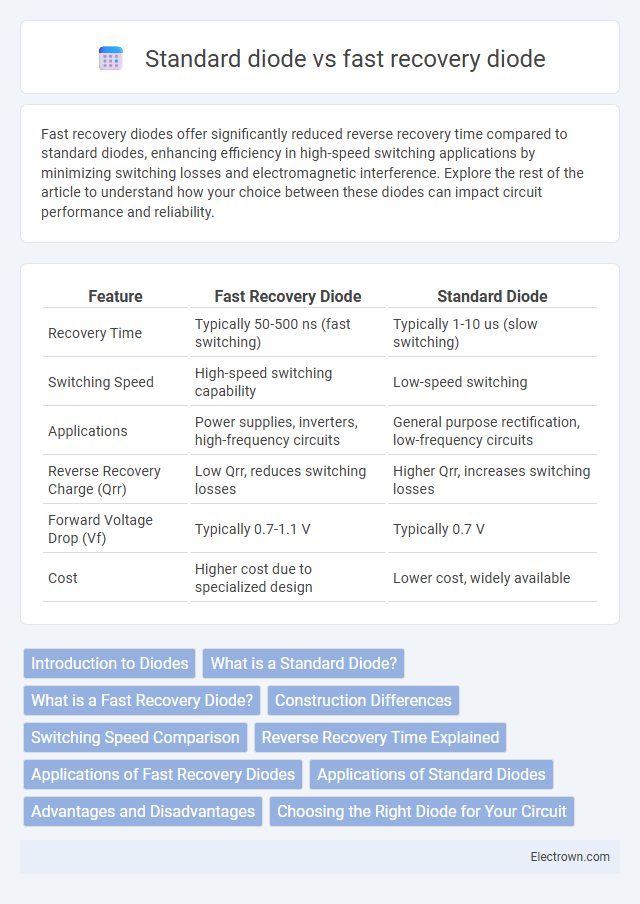Fast recovery diodes offer significantly reduced reverse recovery time compared to standard diodes, enhancing efficiency in high-speed switching applications by minimizing switching losses and electromagnetic interference. Explore the rest of the article to understand how your choice between these diodes can impact circuit performance and reliability.
Table of Comparison
| Feature | Fast Recovery Diode | Standard Diode |
|---|---|---|
| Recovery Time | Typically 50-500 ns (fast switching) | Typically 1-10 us (slow switching) |
| Switching Speed | High-speed switching capability | Low-speed switching |
| Applications | Power supplies, inverters, high-frequency circuits | General purpose rectification, low-frequency circuits |
| Reverse Recovery Charge (Qrr) | Low Qrr, reduces switching losses | Higher Qrr, increases switching losses |
| Forward Voltage Drop (Vf) | Typically 0.7-1.1 V | Typically 0.7 V |
| Cost | Higher cost due to specialized design | Lower cost, widely available |
Introduction to Diodes
Fast recovery diodes feature a significantly reduced reverse recovery time compared to standard diodes, enabling efficient switching in high-frequency applications. Standard diodes typically exhibit longer reverse recovery times, resulting in higher switching losses and electromagnetic interference in circuits with rapid signal changes. The choice between fast recovery and standard diodes directly impacts performance parameters such as switching speed, power efficiency, and thermal management in power electronics.
What is a Standard Diode?
A standard diode is a semiconductor device that allows current to flow in one direction while blocking it in the opposite direction, primarily used for rectification in power supplies. It typically has a slower reverse recovery time compared to a fast recovery diode, making it less efficient in high-frequency switching applications. Your choice between these diodes impacts circuit performance, particularly in terms of switching speed and energy loss.
What is a Fast Recovery Diode?
A Fast Recovery Diode is a semiconductor device designed to switch off rapidly, minimizing the reverse recovery time compared to standard diodes. This rapid switching reduces power loss and electromagnetic interference in high-frequency applications such as power supplies, inverters, and motor drives. Your choice of a Fast Recovery Diode enhances efficiency and performance where quick response to voltage changes is critical.
Construction Differences
Fast recovery diodes feature a thinner epitaxial layer and optimized junction design that drastically reduces reverse recovery time compared to standard diodes. These construction differences minimize charge storage and enable quicker switching, making fast recovery diodes ideal for high-frequency applications. In contrast, standard diodes have a thicker PN junction that results in longer reverse recovery times and slower switching speeds.
Switching Speed Comparison
Fast recovery diodes offer significantly faster switching speeds compared to standard diodes due to their reduced reverse recovery time, which minimizes power loss and improves efficiency in high-frequency applications. Your choice of diode impacts circuit performance, especially in power electronics and switching regulators where rapid switching is essential. Standard diodes have longer recovery times, making them less suitable for high-speed switching tasks.
Reverse Recovery Time Explained
Fast recovery diodes have a significantly shorter reverse recovery time compared to standard diodes, allowing them to switch off quickly and reduce power loss in high-frequency applications. The reverse recovery time is the interval required for the diode to stop conducting current after the voltage polarity reverses, critical in minimizing switching losses and electromagnetic interference in circuits. This rapid transition makes fast recovery diodes ideal for power electronics, inverters, and switching power supplies, where efficiency and thermal management are crucial.
Applications of Fast Recovery Diodes
Fast recovery diodes are essential in high-speed switching applications such as power supplies, inverters, and motor drives where minimizing switching losses and reducing electromagnetic interference is critical. Their rapid turn-off capability enhances performance in devices like rectifiers and snubbers used in high-frequency circuits. Standard diodes, by contrast, are more suited for low-frequency or general-purpose applications where switching speed is less crucial.
Applications of Standard Diodes
Standard diodes are widely used in low-frequency rectification applications such as power supplies, signal demodulation, and basic voltage protection circuits. Their slower switching speeds make them ideal for steady-state DC conversion where high-speed switching is not critical. Common devices utilizing standard diodes include AC to DC converters, battery chargers, and simple clamping circuits.
Advantages and Disadvantages
Fast recovery diodes feature significantly reduced reverse recovery time, minimizing power loss and electromagnetic interference in high-frequency applications such as switching power supplies and inverters. However, they typically exhibit higher forward voltage drop and cost compared to standard diodes, making them less efficient for low-frequency or low-current applications. Standard diodes offer simplicity, lower cost, and robustness but suffer from longer reverse recovery times, resulting in slower switching speeds and increased energy dissipation in dynamic circuits.
Choosing the Right Diode for Your Circuit
Fast recovery diodes offer significantly reduced reverse recovery time compared to standard diodes, making them ideal for high-frequency switching applications and power electronics where efficiency and heat reduction are critical. Standard diodes, with their longer recovery times, are suitable for low-frequency or general-purpose circuits but may cause increased switching losses and electromagnetic interference in fast-switching environments. Choosing the right diode for your circuit involves balancing recovery time, voltage, current ratings, and thermal performance to ensure optimal operation and longevity.
Fast recovery diode vs standard diode Infographic

 electrown.com
electrown.com